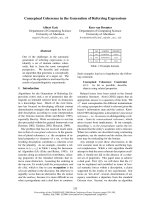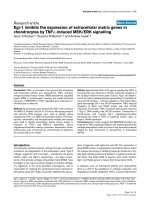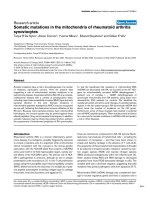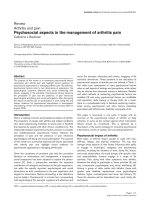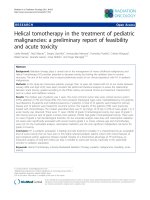Báo cáo y học: " Immune modulation in the treatment of respiratory infection" potx
Bạn đang xem bản rút gọn của tài liệu. Xem và tải ngay bản đầy đủ của tài liệu tại đây (122.48 KB, 3 trang )
commentary
review
reports primary research
Commentary
Immune modulation in the treatment of respiratory infection
Jay K Kolls and Steve Nelson
LSU Health Sciences Center, New Orleans, Louisiana, USA
Abstract
The limitations of currently available treatment for severe respiratory infection are
demonstrated by the relatively fixed mortality associated with these infections despite
advances in nutrition, vaccines, antibiotics, and critical care. This might be due in part to the
changing spectrum of pathogens and development of drug resistance. Cytokines are potent
molecules that function as growth factors and orchestrate both innate and adaptive immune
responses. Several of these factors have entered the clinical arena to support or augment
the immune response. Moreover, the use of cytokines has recently been expanded to
patients without an overtly defective immune system but who have either significant infection
or infection with drug resistant organisms. The use of cytokines as adjuvants in the treatment
of respiratory infections is reviewed.
Keywords: cytokine, gene therapy, immunotherapy, pneumonia
Received: 28 April 2000
Revisions requested: 22 May 2000
Revisions received: 13 June 2000
Accepted: 13 June 2000
Published: 23 June 2000
Respir Res 2000, 1:9–11
The electronic version of this article can be found online at
/>© Current Science Ltd (Print ISSN 1465-9921; Online ISSN 1465-993X)
CAP = community-acquired pneumonia; G-CSF = granulocyte-colony stimulating factor; HLA-DR = human leukocyte antigen-DR; TNF = tumour
necrosis factor.
/>Critical factors that determine the severity of a respiratory
infection include the strain of the pathogen, specific viru-
lence factors of the pathogen, and often the integrity of
the pulmonary host defense response. Acquired defects
include abnormal mucociliary clearance associated with
cigarette smoking [1] to co-morbid conditions such as dia-
betes mellitus [2], ethanol abuse [3], and an abnormal
hematopoietic or immune response to the invading
pathogen [4]. Among these host factors, neutropenia at
the time of presentation has been shown to be an inde-
pendent variable correlated with mortality. Over the past
decade and a half there have been several trials of anti-
inflammatory agents in patients with severe pneumonia
who developed sepsis or the systemic inflammatory
response syndrome. The trials have included inhibitors of
tumor necrosis factor-α (TNF) [5] and endotoxin [6,7]. The
rationale for these trials was based on preclinical models
of endotoxin-induced sepsis demonstrating a survival
benefit if pro-inflammatory cytokines were neutralized [8].
Why have these clinical trials failed to show a survival
benefit, or in some cases an adverse effect on survival?
Some investigators have suggested that the timing of anti-
inflammatory therapy might be too late, that patient selec-
tion was not ideal, or that the preclinical models of sepsis
Respiratory Research Vol 1 No 1 Kolls and Nelson
were not an accurate reflection of human disease. Further-
more, it is now known that many of these cytokines,
specifically TNF, are critical to host defense against both
intracellular and extracellular pathogens [9–12].
Moreover, these pro-inflammatory molecules are relatively
compartmentalized to the site of infection in pneumonia
patients [13–15]. However, there are data to suggest that
in severe infection and lung injury the inflammatory
response is not compartmentalized, and thus the infection
can lead to a systemic inflammatory response, which
might be associated with other organ injury [16–19]. In
fact it has recently been shown that patients with
sepsis/systemic inflammatory response syndrome have an
‘immunoparalysis’ and are in fact, immunosuppressed
[20,21]. This has led to the use of growth factors or
cytokines to augment the host response to infection. Not
all growth factors or cytokines show this compartmental-
ized response; for example, data from our laboratory and
others demonstrate that granulocyte-colony stimulating
factor (G-CSF), a critical growth factor for neutrophil pro-
duction and maturation, is released in the lung in response
to a bacterial challenge and is readily detectable in the
serum within 2h [22]. This makes teleological sense in the
fact that an infected organ would need to send signals to
the bone marrow for a continued supply of neutrophils,
which are required for a sufficient host defense response.
On the basis of favorable preclinical studies with G-CSF,
clinical trials have been initiated in community-acquired
pneumonia (CAP), multilobar pneumonia, and pneumonia
with sepsis. Hustinx et al [23] compared neutrophil func-
tion and phenotype in the blood and bronchoalveolar
lavage fluid of 10 patients with severe ventilator-depen-
dent pneumonia, at baseline and after the initiation of
G-CSF treatment as an adjunct to standard therapy.
These investigators showed that treatment with G-CSF
was associated with a threefold increase in blood neu-
trophil count at day 3 of treatment compared with baseline
counts [23]. Mean serum G-CSF concentration increased
from 313 to 2007pg/ml. The mortality in this group of 10
patients was 30% and compared favorably with the pre-
dicted mortality of 60%, derived from APACHE II. These
data suggested that G-CSF might be an effective
immunomodulator in a variety of non-neutropenic settings
such as hospital-acquired pneumonia or in persons
immunosuppressed by alcohol.
Recently, a phase III, randomized, double blind, placebo-
controlled trial of G-CSF for CAP in hospital has been
completed [24]. Over 756 patients were enrolled in this
multicenter trial in the USA, Canada, and Australia.
Patients were randomized to receive 300µg/day of
G-CSF subcutaneously or placebo in addition to conven-
tional antibiotic therapy. The duration of treatment was up
to 10 days. Primary objectives were to determine the
safety and efficacy of G-CSF in this patient population and
the effect on the time to resolution of morbidity [25]
(TRM), which was a clinical index of factors associated
with the need for continued treatment in hospital. The
TRM was 4 days in both groups and G-CSF was well tol-
erated. Mortality was only 6% in this study and no signifi-
cant difference was seen between groups in this variable.
G-CSF treatment resulted in a threefold increase in
peripheral blood neutrophil count. Post hoc analysis
showed faster radiological resolution in patients treated
with G-CSF, which was associated with fewer complica-
tions including adult respiratory distress syndrome and
disseminated intravascular coagulation.
G-CSF has also been studied in 18 patients with pneumo-
nia and severe sepsis [22]. The patients were randomized
2:1 to G-CSF (300µg/day given intravenously) or placebo
for a maximum of 5 days. Inclusion criteria were a chest
X-ray compatible with pneumonia, an identifiable
pathogen, fever, tachycardia, tachypnea, or need for venti-
lator support, and either hypotension despite volume
resuscitation requiring vasopressors or, in the absence of
shock, two end-organ dysfunctions. Four of six placebo-
treated patients died and three of twelve G-CSF patients
died. Septic shock was resolved in nine of ten G-CSF
patients and in none of the control patients. G-CSF was
well tolerated; on the basis of these favorable trends
further studies in multilobar pneumonia and severe pneu-
monia with sepsis were initiated. They have recently been
completed and are under analysis.
IFN-γ has been investigated in patients with immunoparaly-
sis associated with sepsis. Docke and colleagues have
shown that downregulation of monocyte human leukocyte
antigen (HLA)-DR expression identifies a subgroup of
septic patients with a higher risk of hospital-acquired infec-
tion [20]. Moreover, the investigators showed that the
administration of IFN upregulated HLA-DR expression,
increased lipopolysaccharide-induced TNF responses ex
vivo, and improved clinical parameters of sepsis in eight of
nine patients treated with IFN [20]. IFN has also been inves-
tigated as an aerosol in patients with persistent Mycobacte-
ria avium complex (MAC) infection in hosts not infected
with HIV and in multidrug resistance tuberculosis. Williams
and colleagues from our group recently reported on a
phase I trial of aerosol-administered IFN to patients with per-
sistent MAC infection [26]. All patients tolerated the aerosol
well and three of eight had sputum smears for acid-fast
bacilli (AFB) that converted to negative. Condos et al [27]
have recently reported five patients with multidrug resistant
tuberculosis who received 500µg of IFN aerosol-adminis-
tered three times a week for 1 month [27]. Again, the drug
was well tolerated and all patients had sputum smears for
AFB that converted to negative and a time to positive
culture that increased (from 17 to 24 days; not significant),
suggesting a reduction in organism burden. In addition,
commentary
review
reports primary research
/>patient weight increased or stabilized, and there were
objective decreases in the size of cavitary lesions in all
patients for up to 2 months after treatment had ended.
There has clearly been a paradigm shift in recent years
from inhibiting pro-inflammatory cytokines to selectively
augmenting the cytokine response within a specific com-
partment in infected patients that have some objective
parameter of immunoparalysis. Which specific cytokines
or growth factors have the greatest therapeutic index and
what patient population(s) will derive the greatest benefit
remain to be defined. In addition, what are the best clinical
parameters to follow? For G-CSF, the absolute neutrophil
count might be adequate. However, for drugs such as IFN,
the expression of HLA-DR or ex vivo-stimulated TNF
responses might be required. If so, these assays will be
more difficult to standardize between laboratories. Despite
these unknowns, the incidences of both hospital-acquired
infections and antibiotic resistance are increasing and
immunoadjuvants will probably be a key component of the
weaponry for treating respiratory infections.
References
1. Almirall J, Gonzalez CA, Balanzo X, Bolibar I: Proportion of commu-
nity-acquired pneumonia cases attributable to tobacco smoking.
Chest 1999, 116:375–379.
2. Valdez R, Narayan KM, Geiss LS, Engelgau MM: Impact of diabetes
mellitus on mortality associated with pneumonia and influenza
among non-Hispanic black and white US adults. Am J Pub Health
1999, 89:1715–1721.
3. Ruiz M, Ewig S, Torres A, Arancibia F, Marco F, Mensa J, Sanchez M,
Martinez JA: Severe community-acquired pneumonia. Risk factors
and follow-up epidemiology. Am J Respir Crit Care Med 1999, 160:
923–929.
4. Chanock S: Evolving risk factors for infectious complications of
cancer therapy. Hematol Oncol Clin N Am 1993, 7:771–793.
5. Abraham E, Anzueto A, Gutierrez G, Tessler S, San Pedro G, Wun-
derink R, Dal Nogare A, Nasraway S, Berman S, Cooney R, Levy H,
Baughman R, Rumbak M, Light RB, Poole L, Allred R, Constant J, Pen-
nington J, Porter S: Double-blind randomised controlled trial of
monoclonal antibody to human tumour necrosis factor in treat-
ment of septic shock. NORASEPT II Study Group. Lancet 1998,
351:929–933.
6. McCloskey RV, Straube RC, Sanders C, Smith SM, Smith CR: Treat-
ment of septic shock with human monoclonal antibody HA-1A. A
randomized, double-blind, placebo-controlled trial. CHESS Trial
Study Group. Ann Intern Med 1994, 121:1–5.
7. Ziegler EJ, Fisher CJ Jr, Sprung CL, Straube RC, Sadoff JC, Foulke
GE, Wortel CH, Fink MP, Dellinger RP, Teng NN: Treatment of
Gram-negative bacteremia and septic shock with HA-1A human
monoclonal antibody against endotoxin. A randomized, double-
blind, placebo-controlled trial. The HA-1A Sepsis Study Group. N
Engl J Med 1991, 324:429–436.
8. Beutler B, Milsark I, Cerami A: Passive immunization against
cachectin/tumor necrosis factor (TNF) protects mice from the
lethal effect of endotoxin. Science 1985, 229:869–871.
9. Kindler V, Sappino A-P, Grau GE, Piguet P-F, Vassalli P: The inducing
role of tumor necrosis factor in the development of bactericidal
granulomas during BCG infection. Cell 1989, 56:731–740.
10. Pfeffer K, Matsuyama T, Kundig TM, Wakeham A, Kishihara K, Shahin-
ian A, Wiegmann K, Ohashi PS, Kronke M, Mak TW: Mice deficient
for the 55 kd tumor necrosis factor receptor are resistant to endo-
toxic shock, yet succumb to L. monocytogenes infection. Cell
1993, 73:457–467.
11. Adams LB, Mason CM, Kolls JK, Scollard D, Krahenbuhl JL, Nelson S:
Exacerbation of acute and chronic murine tuberculosis by admin-
istration of a TNF receptor expressing adenovirus. J Infect Dis
1995, 171:400–405.
12. Kolls JK, Lei D, Greenberg S, Nelson S, Beutler B: Adenovirus-medi-
ated blockade of tumor necrosis factor in mice protects against
endotoxic shock yet impairs pulmonary host defense. J Infect Dis
1995, 171:570–575.
13. Nelson S, Bagby GJ, Bainton B, Wilson LA, Thompson JJ, Summer
WR: Compartmentalization of intraalveolar and systemic lipopoly-
saccharide-induced tumor necrosis factor and the pulmonary
inflammatory response. J Infect Dis 1989, 159:189–194.
14. Boujoukos AJ, Martich GD, Supinski E, Suffredini AF: Compartmental-
ization of the acute cytokine response in humans after intravenous
endotoxin administration. J Appl Physiol 1993, 74:3027–3033.
15. Dehoux MS, Boutten A, Ostinelli J, Seta N, Dombret MC, Crestani B,
Deschenes M, Trouillet JL, Aubier M: Compartmentalized cytokine
production within the human lung in unilateral pneumonia. Am J
Respir Crit Care Med 1994, 150:710–716.
16. Kurahashi K, Kajikawa O, Sawa T, Ohara M, Gropper MA, Frank DW,
Martin TR, Wiener-Kronish JP: Pathogenesis of septic shock in
Pseudomonas aeruginosa pneumonia. J Clin Invest 1999, 104:
743–750.
17. Chiumello D, Pristine G, Slutsky AS: Mechanical ventilation affects
local and systemic cytokines in an animal model of acute respira-
tory distress syndrome. Am J Respir Crit Care Med 1999, 160:109–
116.
18. Ranieri VM, Suter PM, Tortorella C, De Tullio R, Dayer JM, Brienza A,
Bruno F, Slutsky AS: Effect of mechanical ventilation on inflamma-
tory mediators in patients with acute respiratory distress syn-
drome: a randomized controlled trial. J Am Med Assoc 1999,
282:54–61.
19. Tremblay LN and Slutsky AS: Ventilator-induced injury: from baro-
trauma to biotrauma. Proc Assoc Am Physicians 1998, 110:482–
488.
20. Docke WD, Randow F, Syrbe U, Krausch D, Asadullah K, Reinke P,
Volk HD, Kox W: Monocyte deactivation in septic patients: restora-
tion by IFN-gamma treatment. Nat Med 1997, 3:678–681.
21. Volk HD, Reinke P, Docke WD: Clinical aspects: from systemic
inflammation to ‘immunoparalysis’. Chem Immunol 2000, 74:162–
177.
22. Nelson S, Summer WR: Innate immunity, cytokines, pulmonary
host defense. Infect Dis Clin N Am 1998, 12:555–567.
23. Hustinx WN, Van Kessel CP, Heezius E, Burgers S, Lammers JW,
Hoepelman IM: Effects of granulocyte colony-stimulating factor
(G-CSF) treatment on granulocyte function and receptor expres-
sion in patients with ventilator-dependent pneumonia. Clin Exp
Immunol 1998, 112:334–340.
24. Nelson S, Belknap SM, Carlson RW, Dale D, DeBoisblanc B, Farkas
S, Fotheringham N, Ho H, Marrie T, Movahhed H, Root R, Wilson J: A
randomized controlled trial of filgrastim as an adjunct to antibi-
otics for treatment of hospitalized patients with community-
acquired pneumonia. CAP Study Group. J Infect Dis 1998, 178:
1075–1080.
25. Daifuku R, Movahhed H, Fotheringham N, Bear MB, Nelson S: Time to
resolution of morbidity: an endpoint for assessing the clinical cure
of community-acquired pneumonia. Respir Med 1996, 90:587–592.
26. Williams LM, Snyder DC, Deblieux P, Ali J, Kuebel D, deBoisblanc BP,
Summer WR: Safety and feasibility of combined aersolized and sub-
cutaneous interferon-gamma as adjuvant treatement of Mycobac-
terium avium complex pulmonary infection in non-HIV infected
hosts [abstract]. Am J Respir Crit Care Med 1994, 149:A110.
27. Condos R, Rom WN, Schluger NW: Treatment of multidrug-resis-
tant pulmonary tuberculosis with interferon-gamma via aerosol.
Lancet 1997, 349:1513–1515.
Authors’ affiliation: Section of Pulmonary and Critical Care,
LSU Health Sciences Center, New Orleans, Louisiana, USA
Correspondence: Jay K Kolls MD, Section of Pulmonary and Critical
Care, LSU Health Sciences Center, Department of Medicine, 1901
Perdido Street, Suite 3205, Box P3-5, New Orleans, LA 70112-1393,
USA. Tel: +1 504 568 4634; fax: +1 504 568 4295:
e-mail:
